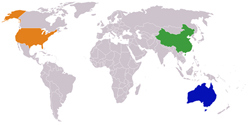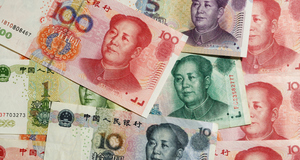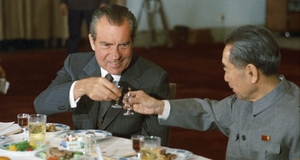Featured Article:The Politics of Cooperation: Analyzing the Relationship Between China, Australia, and the U.S.
By
2010, Vol. 2 No. 12 | pg. 1/1
IN THIS ARTICLE
KEYWORDS
John Howard, then-Prime Minister of Australia, claimed that, ‘I count it as one of the great successes of this country’s foreign relations that we have simultaneously been able to strengthen our long-standing ties with the United States of America, yet at the same time continue to build a very close relationship with China’ (Howard 2004). This statement embodies the ideal vision of Australian foreign policy: a healthy security relationship with the United States complemented by burgeoning economic ties with China (White 2005: 470). However, relations between Australia’s two most important partners are characterised by varying degrees of cooperation and discord. As China’s economic and political weight in the Asia-Pacific region expands, the potential for conflict with the United States over respective strategic and economic interests escalates. How Australia manages these emerging contours for conflict comprises the central challenge to its foreign policy (Kelton 2006: 230).
I. The Present State of Australia's Relations with the US and ChinaA. Australia’s relationship with the United StatesFollowing the conclusion of the Second World War, the United States has enjoyed a central position in the construction of Australian security and economic policy (Beeson 2003: 387). This position has been largely underwritten by a number of key factors, including the ANZUS alliance, common institutions and values, economic linkages and recently, Australian participation in the “global war on terror”. Without delving into discussions which have been entertained by numerous authors elsewhere, it is worth revisiting some salient points. Firstly, Australia’s security partnership with the United States is generally viewed as indispensable, although it is not without its critics (Ex.: Beeson 2003). This notion of the US’ centrality to Australian foreign policy stems from the longstanding belief that Australia’s security is dependent upon sustaining partnerships with great maritime powers (Lyon 2008: 57). Further, given Australia’s presence as an outpost for Anglo-Saxon culture in Asia, a sense of strategic isolation has been cited as a key driver of close security ties between the two nations (McLean 2006: 38; Manicom and O’Neil 2010: 34). The shortcomings of Asian regionalism, as demonstrated by the Asian Financial Crisis (1997), have reinforced this strategic isolation; prompting Australia to shy away from a security policy within Asia’s multilateral institutions (Tow 2004: 276). Secondly, following the events of 9/11 and Australia’s subsequent participation in both Afghanistan and Iraq, the partnership between Australia and the United States has strengthened dramatically. Australia’s decision to invoke the ANZUS treaty after the terrorist attacks of 9/11 displayed a renewed solidarity with the United States (Malik 2006: 587). Australian Defence Forces (ADF) were deployed to both Afghanistan and Iraq to support US efforts in those countries. Specifically, the exercise of American military power in two theatres emphatically highlighted the defence benefits Australia derives from the partnership. In terms of tangible gains from Australia’s close security alignment with the US, benefits include access to high-tech military materiel, extended deterrence guarantees (including nuclear deterrence), and the increased regional profile it receives (Tow 2005: 461; Dibb 2007: 33). Thirdly, the United States is not only an isolated actor: it has an extensive network of partners and allies within Asia and continues to contribute to Australia’s economic prosperity. Manicom and O’Neil note that the economic fortunes of the United States, and its Asiatic strategic partners, Japan and India, will be just as influential on Australia’s economic prosperity as its relationship with China (Manicom and O’Neil 2010: 31). Although two-way trade between Australia and China exceeded the value of Australia-US trade in 2004-2005 (Malik 2006: 589), the United States still remains Australia’s second-largest source of imports (Manicom and O’Neil 2010: 31) and one of the few states it has a Free Trade Agreement (FTA) with. B. Australia’s relationship with ChinaIt is well-accepted that China’s rise has created both opportunities and pressures for the Asian regional order. Australia has certainly capitalised on China’s economic momentum: China is Australia’s largest trading partner and largest export partner, with two-way trade valued at AUD$85 billion in 2009 (Crean 2010). However, Hugh White notes that a notion implicit in China’s economic relationships is that beneficiary states must ‘take careful account if China’s political and strategic interests’ (2005: 470). In accordance with these underlying “rules”, Australia’s accommodation with Chinese interests is being evinced. Two instances are particularly notable. Firstly, in 2004, then-Foreign Minister Alexander Downer discussed the limitations of Australia’s ANZUS obligations in relation to the support of US forces during a potential conflict in the Taiwan Strait. The former Foreign Minister stated, ‘[t]he ANZUS Treaty is invoked in the event of one of our two countries, Australia or the United States, being attacked. So some other military activity elsewhere in the world […] does not automatically invoke the ANZUS Treaty’ (Downer 2004). Downer’s comments are readily contrasted with the Howard government’s position during the 1996 Taiwan Crisis, which strongly supported President Clinton’s dispatch of an aircraft battle group to the Taiwan Strait. Downer’s comments suggest that Australia’s strategic calculus, between 1996 and 2004, has altered. It can be inferred that increasing economic interdependence between Australia and China is at the forefront of this change (Pan 2006: 433; Manicom and O’Neil 2010: 35). In terms of economic interdependence, it is critical to note that (1) Australia’s trade with China constitutes 17 per cent of its total trade (Crean 2010) and (2) the People’s Republic has regularly been portrayed as the ‘locomotive to keep Australia’s economy growing’ (Zhang 2008). The alteration in Australia’s strategic calculus has manifested itself in other ways. In 2008, then-Prime Minister Kevin Rudd terminated Australia’s involvement in the Quadrilateral Dialogue initiative, which included America’s other security partners, Japan and India. Such regional alignments are construed by Beijing as an attempt to contain it and prolong Cold War security architectures (Tow 2004: 53). Clearly, Canberra is looking to dispel such connotations, reinforcing the impression that in light of Australia’s increasing economic ties with China; some of the latter’s foreign policy interests are being accommodated through an adaption of Australian foreign policy. II. Analyzing the Nature and Extent of the 'Difficult Choices' Australian Policy Makers FaceThe pertinent question thus becomes whether the aforementioned accommodation with China’s political and strategic interests will lead Australia to a new strategic direction upon the advent of US-China strategic competition. The answer involves four considerations: (1) the possibility of US-China strategic competition intensifying; (2) the theoretical basis for Australia’s alliance decisions; (3) assessing what category of conflict would “force” Australia to choose and (4) evaluating which policy option is most plausible for Canberra to implement. A. The potential for increased Sino-American strategic competitionThe potential for future Sino-American strategic competition is very much an open-ended question. The United States’ contemporary China policy possesses both cooperative and competitive elements; including an eclectic mix of ‘engagement, binding and balancing mechanisms’ (Mederios 2005: 147). On the other hand, according to Rex Li, China’s foreign policy toward the United States is driven by the defence of what it considers as its ‘vital economic and security interests’ (Li 2004: 25). The central consideration is whether the US’ “congagement” posture vis-à-vis China will significantly intrude on Beijing’s economic and security imperatives (or vice-versa) so as to engender bilateral discord. The probability of such an occurrence depends on systemic considerations, such as international institutions and balance of power mechanics in addition to the respective foreign and domestic policies of Washington and Beijing (Shambaugh 2000: 211). David Scott states that such uncertainty is compounded by ‘the constraints of theory’ (2007: 144). The use of International Relations (IR) theory to hypothesise potential conflict has constituted an enduring feature of Sino-American international relations literature. The vast range of IR theories and sub-schools foster a debate which primarily focuses upon divergent elements of Sino-American ties. For instance, IR liberalism emphasises the role of economic interdependence and international institutions in dampening the potential for Sino-American conflict whereas IR offensive realists attach higher importance to China’s defence spending and expanding territorial claims (Ibid). Rather than review the totality of the present literature here, it is necessary to examine the core theoretical standpoint which has informed the debate over future Sino-American competition: power-transition theory. Power-transition theory relies on historical precedent to demonstrate that rising powers tend to utilise their growing economic strength to pursue expansionist, or assertive, foreign policies (Li 2004: 36; Shambaugh 2000: 212). War is posited by power transition theorists as a mechanism to accelerate, or complete, the transition of power (Organski 1958). Power-transition theorists further note that war will only eventuate if the ascendant power is dissatisfied with the status quo of the international system (Tammen et al. 2000: 28). Chinese foreign policy, as part of a wider function of the “China threat” phenomenon, has often been portrayed as “revisionist” in nature and consequently destabilising for the international system (Ex.: Mearsheimer 2001). The theoretical discussions centred on Sino-American strategic competition are not unlikely to be determinative for Australia’s foreign policy direction. As will be argued in Section C, what matters for Australian foreign policy is not whether strategic competition exists per se, but rather what such strategic competition will constitute. B. Theoretical mechanism for evaluating Australia’s response to increased Sino-American competitionAustralia’s response to any instance of adversarial Sino-US conflict is largely predicated on contextual factors (Malik 2006: 591). However, this essay posits that dissecting the theoretical machinations of Australia’s potential reaction is nonetheless significant. Stephen Walt’s “balance of threat” theory has occupied a revered position in alliance studies. The central tenet of to Walt’s concept is that ‘states will ally with, or against, the most threatening power’ (1985: 8-9). The theory is appropriate in analysing Australian security policy, which, for much of the twentieth century, was predicated upon guarding against external security threats (Harris 1995: 246). Importantly, the Waltian notion of a “threat” is largely grounded in the orthodoxy of traditional security, with military considerations at its core. However, this should not preclude the conception of “threat” being broadened to accommodate other contemplations of security. After all, any comprehensive alliance theory must take into account the circumstances in which a state’s security policy operates (Ross 2006: 363). Due to the unlikelihood of an attack on the Australian continent (Tow 2004: 276), military security may be a relevant to, but not necessarily determinative of, Australia’s security policy. For example, Australia, as a trading nation, is particularly dependent on commercial ties with East Asia (Ibid). As such, this essay utilises a broader notion of “threat” to assess construct Australia’s response to increased strategic competition between the United States and China. C. Australia’s projected response to Sino-American competitionThis final consideration addresses whether, on a balance of probabilities, Australia would align with the United States, China or embrace strategic independence during US-China strategic competition. An underlying concern in this particular consideration is: what category of strategic competition would elicit such a choice? After all, not every dispute between Beijing and Washington, such as the revaluation of the yuan or economic sanctions on the recalcitrant Iranian regime, results in Canberra being forced to choose between the foreign policy imperatives of its two most important partners. It is arguable that military confrontation between the United States and China would result in the imposition of a “choice” for Australian foreign policy makers (Malik 2006: 591). William Tow describes military conflict between America and China as a veritable ‘alliance management nightmare’ (2006: 455). The likeliest sources of Sino-American military conflict are either Taiwan or a regional flashpoint such as North Korea, both of which are viewed, by Chinese policy makers, as lying squarely within China’s strategic space (Manicom and O’Neil 2010: 33). Conflict over Taiwan is particularly disastrous for Canberra, as the “Armitage Scenario”, whereby it has been suggested that the United States expects Australia’s military support in the event over a Taiwan Strait crisis, and, if such support were not readily provided, the ANZUS security arrangement would be considered compromised (Tow and Hay 2001: 42). Considering the scenario’s implications, whether Canberra could opt out of any Taiwan Strait crisis would depend on numerous variables, including the origin of the conflict, and domestic policy considerations (Malik 2006: 591). In a similar vein, it is unlikely that Australia’s commercial ties with Beijing would survive any military support for US combat forces engaged against the People’s Liberation Army and its maritime and air force counterparts. Consequent upon that, Australia’s choices during any Sino-American military conflict would be incredibly difficult. As William Tow and Leisa Hay state, ‘[t]here is no cost-free policy for Australia in this equation […] [it] has no choice but to calculate relative costs and gains’ (2001: 40). However, there is one option which may be easier to exclude. That is, in the event of increased Sino-American competition, Australia is unlikely to align with China. Granted, increased commercial ties with China have, to date, translated into accommodation of some Chinese foreign policy preferences. However, this does not mean that Australia would refuse to support the United States in a conflict against China (Manicom and O’Neil 2010: 40). By not aligning with China, Australia minimises the potential to subject itself to an existential security dilemma. According to William Tow, security alignment with China against the United States would result in deleterious long-term costs to national security (2005: 460). Australia’s defence policy “blueprint”, with ANZUS at its centre, would be shattered; likely constituting an unacceptable situation whereby Australia is the sole guarantor of its security (Ibid). This situation would likely result in unpalatable increases in defence expenditure and deficiencies in Australia’s defence capabilities. Presently, Australia’s access to US intelligence and military technology (Tow 2004: 275-6) allows it to reap defence benefits from the alliance. Given the present conventional military supremacy of the United States, ANZUS-related defence benefits are highly regarded (Tow 2005: 455) and are unlikely to be matched through an alignment with China. Alignment with China is made more unlikely when one considers the disparity between the polities of the People’s Republic and Australia. Mohan Malik has ascribed this factor to the pre-existing lack of strategic cooperation between Australia and China (2006: 594). Stephen Walt ascribed the lack of tangible alliances between states with divergent political or cultural traits to a conception of “ideological solidarity”, which was first advanced by Hans Morgenthau (Walt 1985: 17). The basis of such ideological solidarity was reduced levels of fear between comparable governmental systems (Ibid: 19). Walt has further argued that the institutionalisation of an alliance prolongs its endurance, even in the face of an altered external threat environment (1997: 165). It is arguable that Australia-US joint defence facilities such as Pine Gap, located in central Australia, and Australia’s reliance on American signals intelligence and satellite communications have successfully enmeshed Australian-American defence cooperation (Waters and Ball 2005: 63). Certainly, there would be economic costs associated with an Australian decision to not align with China. Robert Ross argues that secondary states, like Australia, are systemically drawn to rising economic powers (2006: 366). The reason for this is grounded in the economic and political benefits of access to a developing market, including growth, employment and political stability (Ibid). Ross writes that, ‘[a]n economic power’s leverage over a secondary state develops in proportion to the difference in relative dependence between the two trading states and thus the relative costs of trade disruption’ (Ibid). However, it is arguable that China’s economic relevance to Australia has not reached the vertex which would preface an alignment with China. As a mineral exporter, Australia’s commodities are highly sought-after, particularly within the Asian region, the centre of world economic growth in the twenty-first century. With a rising India, supplemented by demand from Japan and Korea, Australia’s dependency on the Chinese market may be exaggerated (Wesley 2007: 77). III. ConclusionIn the event of increased Sino-American strategic competition which results in the creation of a forced “choice” for Australian policy makers, Australia is likely to support the United States. The arrival at such a decision involves a strenuous detriment evaluation, which would likely revolve around contextual factors, which would inform subsequently inform the present status of Canberra’s relationships with each respective state. Canberra’s choice would not be without commercial and diplomatic cost, yet the course of action projected by this essay is indicated by the substantial benefits the alliance with the US grants Australia, in terms of military hardware, logistical support and a heightened international profile. Canberra’s relationship with Beijing presently possesses neither the scope nor depth of economic, political or military engagement to ultimately dislocate its relationship with the Washington. References--. (1985) International Security Vol. 9, No. 4, pp. 3-43. --. (2004) “Geopolitics, the ‘National Interest’ and the Sino-Australian Conundrum” in Nicholas Thomas (ed.) Re-Orienting Australia-China Relations: 1972 to the Present, Ashgate Publishing Limited, England: pp. 51-67. Beeson, Mark (2003) “Australia’s Relationship with the United States: the Case for Greater Independence,” Australian Journal of Political Science Vol. 38, No. 3, pp. 387-405. Dibb, Paul (2007) “Australia-United States” in Brendan Taylor (ed.), Australia as an Asia-Pacific Regional Power: Friendship in Flux? Routledge, New York, pp. 33-50. Kelton, Maryanne (2006) “Perspectives on Australian foreign policy, 2005” Australian Journal of International Affairs, Vol. 60, No. 2, pp. 229-246. Li, Rex (2004) “Security Challenge of an Ascendant China: Great Power Emergence and International Stability” in Suisheng Zhao (ed.), Chinese Foreign Policy: Pragmatism and Strategic Behaviour, East Gate, New York, pp. 23-58. Lyon, Rod (2008) “Australia-US Relations: the future of the ANZUS alliance” in Carl Ungerer (ed.) Australian Foreign Policy in the Age of Terror , University of New South Wales Press, Sydney, pp. 52-74 Medcalf, Rory (2008) “Chinese Ghost Story” The Diplomat, pp. 16-18. Mederios, Evan S. (2005)“Strategic Hedging and the Future of Asia-Pacific Stability” The Washington Quarterly, Vol. 29, No. 1, pp. 145-167. Mackerras, Colin (2000) “Australia-China Realtions at the End of the Twentieth Century,” Australian Journal of International Affairs, Vol. 54, No. 2, pp. 185-200. Manicom, James and O’Neil, Andrew (2010) “Accommodation, realignment, or business as usual? Australia’s response to a rising China,” The Pacific Review, Vol. 23, No. 1: pp 23-44. McLean, David (2006) “From British Colony to American Satellite? Australia and the USA during the Cold War” Australian Journal of Politics and History, Vol. 52, No. 1, pp. 64-79. Pan, Chengxin (2006) “Neoconservatism, US-China conflict, and Australia’s ‘great and powerful friends’ dilemma” The Pacific Review, Vol. 19, No. 4, pp. 429-448. Rosecrance, Richard (2006) “Australia, China and the US,” Australian Journal of International Affairs, Vol. 60, No. 3, pp. 364-368. Ross, Robert S. (2006) “Balance of Power Politics and the Rise of China: Accommodation and Balancing in East Asia” Security Studies, Vol. 15, No. 3, pp 355-395. San Pablo-Baviera, Aileen (2003) “The China factor in US alliances in East Asia and the Asia Pacific,” Australian Journal of International Affairs, Vol. 57, No. 2, pp. 339-352. Shambaugh, David (2000), “Containment or Engagement of China? Calculating Beijing’s Responses,” The Rise of China (Brown et al. (ed.)), MIT Press, Cambridge, pp. [need pages] Sutter, Robert (2002), “Thirty years of Australia-China relations: an American perspective” Australian Journal of International Affairs, Vol. 56, No. 3, pp. 347-360 Tow, William T. and Hay, Leisa (2001) “Australia, the United States and a ‘China growing strong’: managing conflict avoidance” Australian Journal of International Affairs, Vol. 55, No. 1, pp. 37-54 Tow, William T. (2005) “Sino-American relations and the ‘Australian factor’: inflated expectations or discriminate engagement?” Australian Journal of International Affairs, Vol. 59, No. 4, pp. 451-467. Tow, William T. (2004) “Deputy Sheriff or independent ally? Evolving Australian-American ties in an ambiguous world order” The Pacific Review, Vol. 17, No. 2, pp. 271-290. Walt, Stephen M. (1997), “Why alliances endure or collapse” Survival Vol. 39, No. 1, pp. 156-179. Wesley, Michael (2007) “Australia-China” in Brendan Taylor (ed.), Australia as an Asia-Pacific Regional Power: Friendship in Flux? Routledge, New York, pp. 50-60. White, Hugh (2005) “The limits to optimism: Australia and the rise of China” Australian Journal of International Affairs, Vol. 59, No. 4, pp. 469-480. Suggested Reading from Inquiries Journal
Inquiries Journal provides undergraduate and graduate students around the world a platform for the wide dissemination of academic work over a range of core disciplines. Representing the work of students from hundreds of institutions around the globe, Inquiries Journal's large database of academic articles is completely free. Learn more | Blog | Submit Latest in Political Science |

 To elucidate the difficult choices Australia would encounter following the intensification of Sino-American strategic competition, this article considers (1) the present state of Canberra’s relations with Washington and Beijing; (2) the possibility for, and categories of, conflict which may lead Canberra toward explicitly “choosing” either Washington or Beijing over the other; (3) the factors which would inform Canberra’s decision-making calculus; and (4) who, on a balance of probabilities, Canberra would support in the event of serious Sino-American conflict.
To elucidate the difficult choices Australia would encounter following the intensification of Sino-American strategic competition, this article considers (1) the present state of Canberra’s relations with Washington and Beijing; (2) the possibility for, and categories of, conflict which may lead Canberra toward explicitly “choosing” either Washington or Beijing over the other; (3) the factors which would inform Canberra’s decision-making calculus; and (4) who, on a balance of probabilities, Canberra would support in the event of serious Sino-American conflict.
















